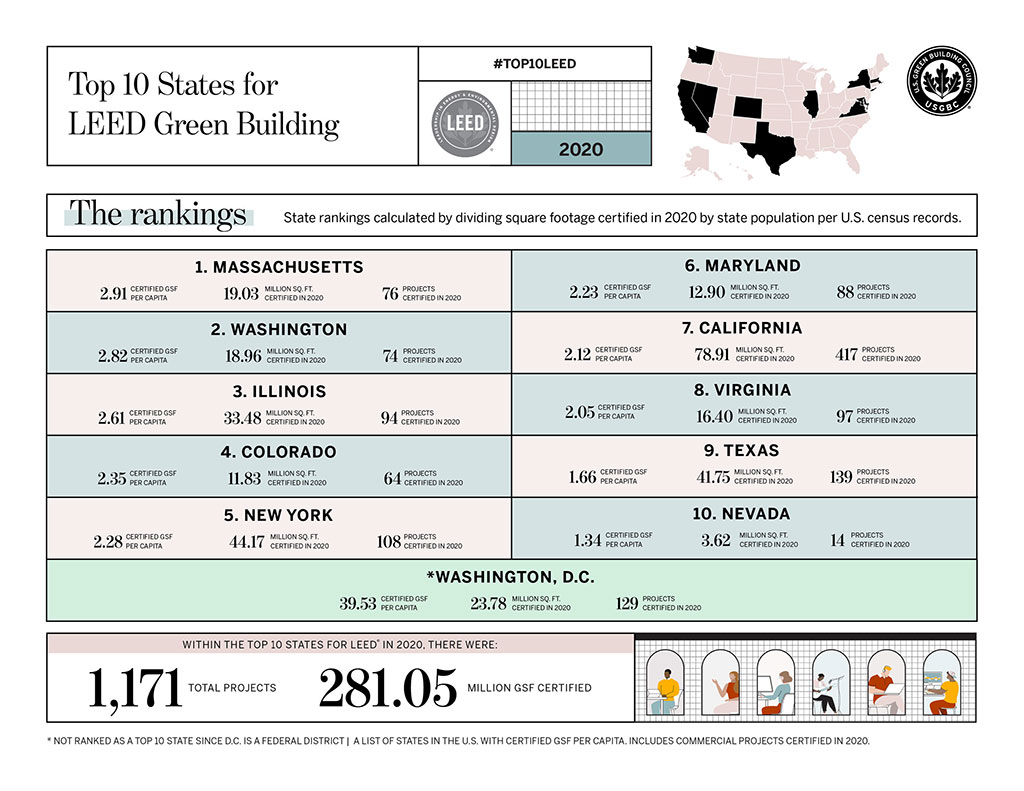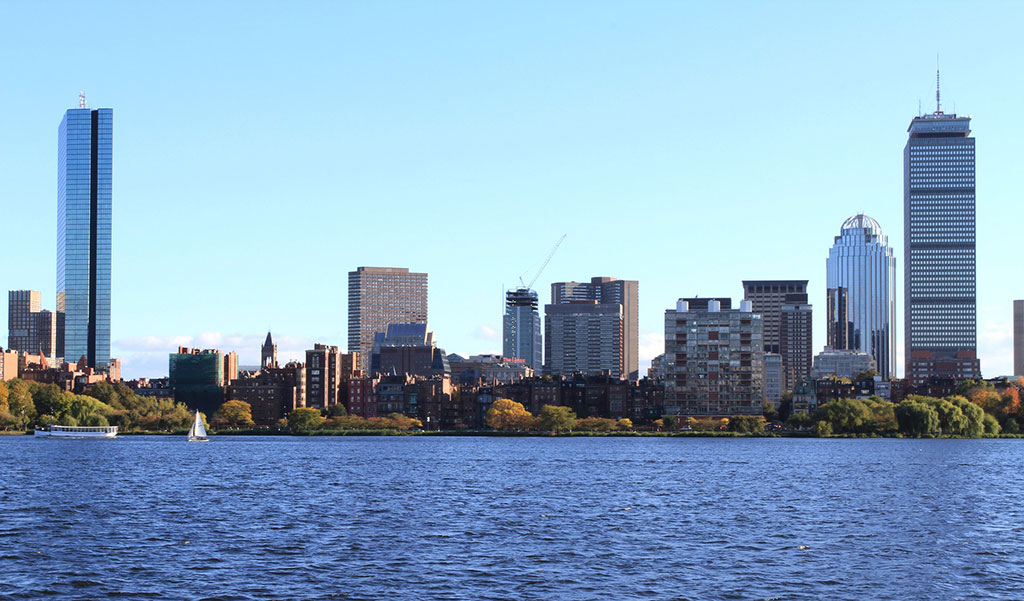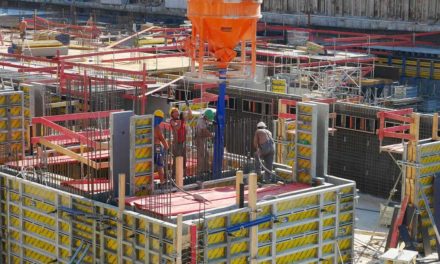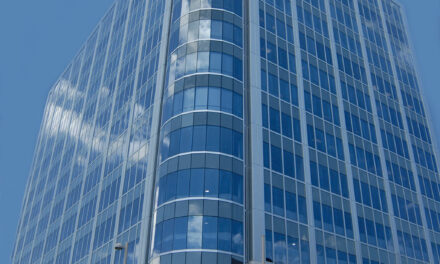WASHINGTON, Feb. 9, 2021 /PRNewswire/ — Today, the U.S. Green Building Council released (USGBC) its annual list of the top 10 states for LEED green building with Massachusetts ranking first in the nation. LEED is the world’s most widely used green building program and was created by USGBC to set standards and define best practices for high-performing, healthy, green buildings. The top states in 2020 certified a remarkable 1,171 projects with more than 60% representing offices, education and healthcare facilities.

(PRNewsfoto/U.S. Green Building Council)
“If we are to rebuild an economy that supports our health and our planet, we must lead with changing the way we design and build,” said Mahesh Ramanujam, president and CEO of USGBC. “Last year was a stark reminder that the quality of our buildings impacts the quality of our life. Looking ahead, people want to trust that the spaces they occupy are good for them and their communities, and LEED has always been a tool to support those goals. Now is the time to ensure that every building is LEED certified as that is the only way we are accomplishing our goals of access to healthy, green buildings, homes and spaces.”
The ranking is based on gross square feet of certified space per person using 2010 U.S. Census data and includes commercial and institutional projects certified in 2020. The full top 10 rankings for 2020 are as follows:
| Rank | State | GSF Per Capita | 2020 Certifications | 2020 GSF |
| TOP 10 TOTALS | 1,171 | 281,055,474 | ||
| 1 | Massachusetts | 2.91 | 76 | 19,034,129 |
| 2 | Washington | 2.82 | 74 | 18,957,253 |
| 3 | Illinois | 2.61 | 94 | 33,475,682 |
| 4 | Colorado | 2.35 | 64 | 11,826,927 |
| 5 | New York | 2.28 | 108 | 44,172,684 |
| 6 | Maryland | 2.23 | 88 | 12,898,921 |
| 7 | California | 2.12 | 417 | 78,912,603 |
| 8 | Virginia | 2.05 | 97 | 16,404,078 |
| 9 | Texas | 1.66 | 139 | 41,749,345 |
| 10 | Nevada | 1.34 | 14 | 3,623,852 |
| * | District of Columbia | 39.53 | 129 | 23,783,731 |
*Washington, D.C. is not ranked due to its status as a federal district.
Green building leadership in 2020
Buildings account for an estimated 39% of total U.S. energy consumption and transitioning these spaces to be more sustainable is key to climate action. The global green building community is continually improving LEED to ensure it helps buildings, communities and cities to be more sustainable, healthy, resilient and equitable. LEED provides a framework for designing, constructing and operating buildings that are cost-effective, reduce carbon, use fewer resources and support human health.
In 2020, LEED green building was not limited to a single part of the country and reflects progress across east, west, south and Midwest regions. Of note is that nearly 50% of projects in the top 10 states achieved LEED Gold, one of the highest levels of certification, indicating a commitment to high performance.
While offices, education and healthcare accounted for a majority of certifications in the top 10 states, warehouses, distribution centers, multifamily housing and retail projects represented almost 20%. LEED can be used by virtually any building type and has been adopted across industries to support corporate sustainability and ESG commitments, as well as by the public sector. President Biden recently signed an executive order around greening the federal government’s own footprint, which includes its buildings. During his campaign, then candidate Biden also committed to upgrade four million buildings in four years as part of a sustainable infrastructure and clean energy plan.
Path to net zero
Over the last year, commitments to net zero emissions have roughly doubled, according to the United Nations Framework Convention on Climate Change. Transitioning buildings to also be net zero is a critical factor in reaching those larger goals. USGBC’s LEED Zero certification is that pathway for buildings and verifies achievements in net zero carbon, energy, water and waste.
In the two years since LEED Zero launched, certifications have doubled, and the number of projects certified in 2020 exceeded 2019. Among the top 10 states for LEED, six are home to LEED Zero projects, including Virginia, California, Illinois, New York, Colorado and Maryland.
Growing the green workforce
Transforming the building sector to be green requires a skilled and knowledgeable workforce. This workforce is contributing to the development and advocacy of LEED and is being quickly embraced by the next generation workforce and decision makers. To aid in its commitment to supporting a green workforce, this year, USGBC is also releasing a first-ever ranking of the top 10 states with the most LEED green building professionals. The list represents more than 100,000 workers with thousands more outside the top 10 and around the world.
Top 10 States for LEED Professionals in 2020
| Rank | State | Total # of Credential Holders |
| TOP 10 TOTAL | 100,015 | |
| 1 | California | 26,906 |
| 2 | New York | 12,575 |
| 3 | Texas | 10,474 |
| 4 | Florida | 9,694 |
| 5 | Illinois | 8,640 |
| 6 | Massachusetts | 6,901 |
| 7 | Virginia | 6,612 |
| 8 | Colorado | 6,393 |
| 9 | Washington | 5,968 |
| 10 | Pennsylvania | 5,852 |
More information about LEED certification and green building is available at usgbc.org.
About the U.S. Green Building Council
The U.S. Green Building Council (USGBC) is committed to a healthy, resilient and equitable future for all through the development of green buildings, cities and communities. For more than 20 years, USGBC has been advancing green building practices through the development of LEED, the world’s most widely used green building program. With the support of thousands of members, volunteers and partners, USGBC provides robust green building education courses, a rigorous professional credentialing program, and advocates for effective public policies. It convenes an international network of green building and sustainability leaders through the annual Greenbuild International Conference & Expo, and forward thinking programs, including the Center for Green Schools. For more information, visit usgbc.org and connect on Twitter, Facebook, Instagram and LinkedIn.





